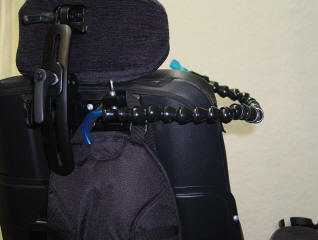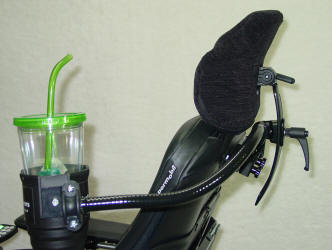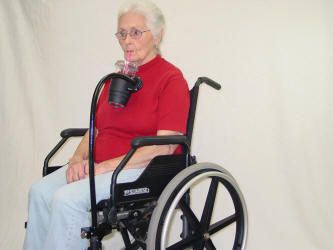November 2020 Independent Eating and Drinking Newsletter
| Independent Eating and Drinking are Wonderful |
 |
| November Newsletter Topics: |
|
| Subscribe to Newsletters, or Unsubscribe from Newsletters |
Designing Feeding Equipment – The Final Word!
Over the last few months this Newsletter has discussed the evolution of dining equipment, some of the features and shortcomings of early designs, and the minimal amount of research that has been conducted regarding feeding equipment. To end this series of discussions we will provide some more detailed insight into various features and the pros and cons of them.
Access to equipment is one of the most significant issues that restrict people from using dining equipment. All commercially available dining equipment, except the Mealtime Partner Dining System, are placed on a table for use and have no other way of being mounted, thus limiting the number of people who are able to use them. This issue was identified in studies conducted by researchers at The Arc of the United States. Why people can’t reach equipment that is placed on a table was discussed in last month’s Newsletter, however, the solution to this problem was not discussed. The Arc’s research team concluded that to provide access to equipment for those who physically, and/or cognitively, are unable to use dining equipment that sits on a table was to lift the entire system up off of the table surface and have it cantilever towards the user so that the spoon could come directly to the user when it was full of food. To accomplish this they designed various methods of mounting their equipment (now known as the Mealtime Partner Dining System). Even though the Mealtime Partner can be placed directly on a table for use like the other systems, it can also be mounted on a support arm. The support arm allows very precise positioning for individuals who have minimal ability to move. Or the Partner can be mounted on a shaft that lifts the device to the appropriate height for use and allows the device to pivot towards the user for easy access to the spoon for users who sit in a wheelchair at mealtimes. Alternately, it can be lifted off of the table using legs for those users who sit at a table to eat and are tall enough to need the device raised to their mouth level.
 |
 |
|
Fig. 1 - Mealtime Partner Sitting on a Table |
Fig. 2 - Mealtime Partner Mounted on Legs |
 |
 |
| Fig. 3 - Mealtime Partner Mounted on the Support Arm | Fig. 4 - Mealtime Partner Mounted on a Shaft |
The typical design of a dining system, over many years, has tried to replicate a normal mealtime setting with a plate or bowl on the table in front of the person eating. To automate eating, an arm is attached to the base of the device which holds the plate or bowl. A spoon is attached to the opposite end of the arm and the arm is constructed in sections that are hinged or otherwise connected to allow flexibility of movement. This allows the spoon to be moved around the plate or bowl to pick up food and then it can extend upward from the plate, and outward, to offer the food on the spoon to the user. However, the older designs had no method for controlling the volume of food on the spoon and so could sometimes have a huge amount of food on the spoon which might spill while it is moving from the plate to the user’s mouth. Alternately, the spoon might not pick up any food and an empty spoon might be offered to the user. Additionally, the movement of the spoon/arm could, for some users, cause a startle reflex. Lastly, most of the older dining systems used a bowl or plate that had no way of separating the food that was being served. As the meal progressed the spoon swept through the food repeatedly and the food was gradually mixed together into a unappealing concoction.
To solve the problems described in the previous paragraph the Mealtime Partner Dining System, has several unique design features. Rather than using a plate, it has 3 bowls that are mounted on a lazy Susan style support that allow food to be kept separated. This design feature permits the bowls to rotate, offering the user the ability to select different food from each bowl. Because the entire Mealtime Partner Dining System is raised off of the table (as described earlier) rather than the spoon being mounted on an arm that has to travel from a plate on the table to the user’s mouth, the spoon rests above the bowl that is positioned closest to the user. When activated the spoon dips down into the bowl, and scoops up the food that is in that bowl. Each bowl has a partial cover that is attached to it; the cover shapes the food removing excess from the top of the spoon, and then extends out from the bowl to a position close to the user’s mouth as shown in Figure 5.
 |
| Figure 5: Mealtime Partner Serving Peas with Spoon Extended to User |
The user simply needs to move their head slightly (about half an inch) towards the spoon and close their lips around the spoon to remove the food. Three differently shaped bowl covers are available and any of them can be attached to each bowl. This allows for different volumes of food to be served from each bowl, if desired. Because the Mealtime Partner Dining System spoon movement throughout the process of scooping food from the bowl and extending out from the bowl to the user is smooth and compact it is less likely to cause the user to have a startle reflex.
The Mealtime Partner Dining System design is unique among feeding devices. The reason for its distinctive design is because the original research team from The Arc of the United States recognized that the recurring style used for feeding equipment had significant short comings that limited access to the equipment for those people who need it most. Having conducted extensive investigation into what worked and what didn’t, the Mealtime Partner Dining System was developed. For more information about the Mealtime Partner Dining System click here. Or, please call 800-996-8607 or email us at: support@mealtimepartners.com.
| HOLIDAY GIFT IDEAS FOR YOUR LOVED ONES | ||||
| A
hands-free drinking system can enable someone to drink independently
throughout the day and is a gift that they will appreciate all year long. Mealtime Partners, Inc. has several different types of hands-free drinking systems to choose from: the Hydration Backpack with Drinking Tube Positioning; the Front Mounted Drinking System; and the Drink-Partner. They can all be attached to any wheelchair that has an exposed frame, handles, or slide-track rails to facilitate mounting, which allows them to be positioned to meet the individual user’s needs. |
||||

|
||||
| Hydration Backpack with Drink Tube Positioning | ||||
  |
||||
|
Front Mounted Drinking System for Wheelchairs with Slide-Track |
Front Mounted Drinking System for Manual Wheelchairs |
|||
| To view all of the Mealtime Partners drinking products, click here. Remember, Mealtime Partners drinking products can be attached to powered wheelchairs with slide rails (standard and unitrack), manual wheelchairs with handles and/or tubular frames, on many standard wheelchairs, or on hospital beds with plastic or metal bed rails. For additional guidance about how to select the appropriate drinking system for your specific needs, click here. | ||||
Remember, Drink Water Even When it's Cold Outside
There are some basics that should be considered before examining the more complex findings of some of the current research about water temperature. The type of water that is being consumed is ultimately the most important factor. Tap water, depending upon where you live in the US, is mostly safe to drink and contains minerals that are natural to the local area. Water can be hard or soft, depending upon the minerals in it; it can come from a lake, well, or spring, or can be distilled. There is an extensive variety of water that is available for purchase if you are willing, and able, to buy it. In some areas of the country, tap water is not safe to drink. This was brought to the public’s attention when reports of the water supply in Flint, a town 40 miles north of Detroit, Michigan, was found to have extremely high levels of lead in it. Children who have been exposed to elevated levels of lead are at increased risk for cognitive and behavioral problems during development. The lead in Flint was found to be leaching from the pipes that supplied water to homes in the area. This occurred because the water, which was being drawn from the Flint River, was 19 times more corrosive than water from the previous water supply, Lake Huron. Had the river water been treated with an anti-corrosive agent, as federal law requires, the leaching would not have occurred, and the tap water in Flint would still have been safe to drink.
Homeostasis is the process by which the human body keeps itself regulated. Despite differences in environment, the human body maintains properties like its fluid content, temperature, mineral, and glucose content at a relatively stable level. Water is essential for survival. Without water a human can only survive for a few days. Dehydration (the excessive loss of fluid from the body) can happen rapidly, especially in hot environments. The body tries to maintain its core temperature at a constant level. When the body gets hot, sweating begins and the moisture evaporating on the surface of the skin helps to cool the body. Yet, if you do not move to a cooler environment and rehydrate your body, even with sweating, dehydration will worsen. Thirst is the primary signal that the body provides to alert us that our fluid levels are getting low. We should drink regularly and not wait until we are thirsty to take a drink. Thirst is an early indicator that the body is already low on fluid.
The recommended quantity of water that should be consumed on a daily basis varies from country to country. The reasons for this are various. The location of the country impacts the need and frequency of body fluid replacement. Extreme temperatures cause the body to need more fluid. The diet of the inhabitants of a specific location also impacts the fluid intake that they require. (For example, in the US it is estimated that approximately 22% of the fluid that we consume comes from the food that we eat, yet European countries, who consume more fruits and vegetables than the US population, get considerably more water from the food that they eat.) Water quality also affects the amount of liquid consumed. In many countries water must be boiled before it is consumed and thus it is not as readily available as if you can simply turn on a tap and drink. For those who must boil water before drinking it, it is common for them to drink it warm or consume it hot made into tea. In China very little water is drunk and yet tea and warm water are constantly consumed.
Returning to the discussion about water temperature in the process of rehydration requires an explanation of how the body responds to heat and loss of fluids. As mentioned earlier, the first thing that the body does when it starts to get hot is to sweat; however, if it continues to be hot, it eventually stops sweating to conserve body fluids. Sweating will restart rapidly after liquid has been consumed. In addition, it has been found that we drink more fluid when it is cool, not cold or hot. When recovering from dehydration our return to sweating is more rapid and profuse when the liquid consumed is around 16o C (around 60o F) or the temperature of cool tap water.
Hopefully, this article will remind readers that regardless of whether the weather is hot or cold, we all need to remember to drink plenty of water. For those who are unable to take a drink without help, Mealtime Partners offers an assortment of hands-free drinking systems. For more information about these systems click here.
|
Did you know? Did you know that the progression of amyotrophic lateral sclerosis (ALS) has been shown to be slowed with the treatment of a new experimental drug called AMX0035? Researchers at the Sean M. Healey and AMG Center for ALS at Massachusetts General Hospital found that the drug, manufactured by Amylyx Pharmaceuticals, Inc., showed that it could slow the progression of ALS. One hundred and thirty seven people participated in the clinical trial of AMX0035 with 2/3 receiving the drug and 1/3 receiving a placebo. The trial showed that over 6 months, participants taking the drug demonstrated a slower progression of the disease than those taking a placebo. Information about this trial was published in the September 2020 issue of the New England Journal of Medicine. |
Click here to subscribe to the Mealtime Partners Newsletters
Please send comments and suggestions to newsletters@mealtimepartners.com
Copyright © Mealtime Partners, Inc. 2020
All rights reserved.
Mealtime Partners Website Navigation: